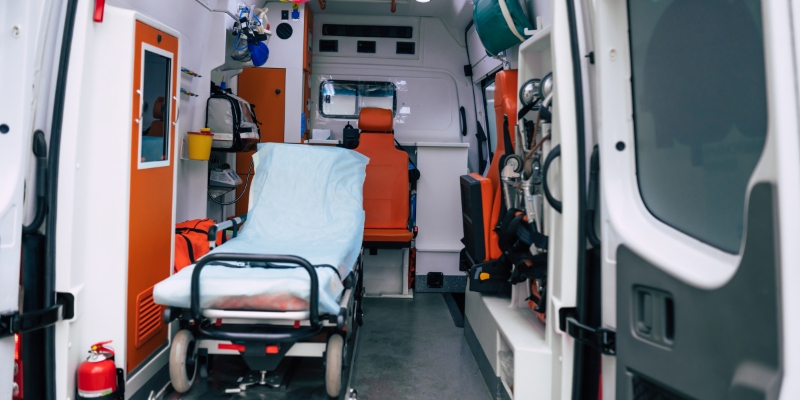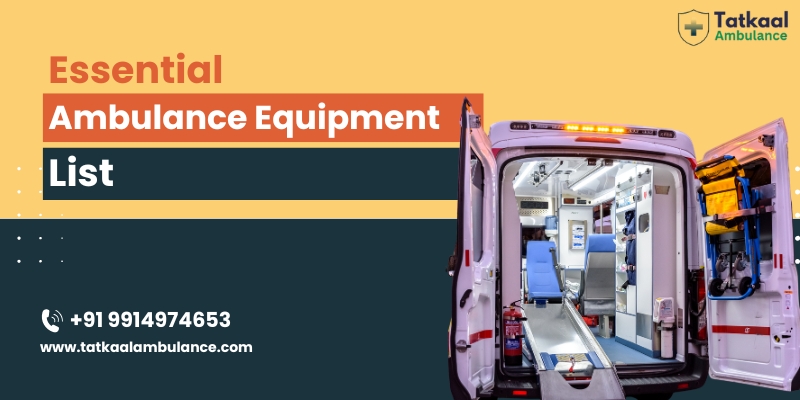When an emergency strikes, every second counts. Ambulances are more than just vehicles—they are mobile hospitals designed to save lives on the move. The equipment inside an ambulance can make all the difference between life and death. From basic first aid tools to advanced life support systems, every piece of equipment plays a crucial role in patient care.
In this blog, we’ll take a closer look at the essential ambulance equipment list that every emergency vehicle must have. Whether it’s a Basic Life Support (BLS) or Advanced Life Support (ALS) ambulance, understanding these tools helps us appreciate the incredible work of emergency medical teams.
Why Ambulance Equipment Matters
Ambulances are mobile emergency care units. From heart attacks and strokes to accidents and childbirths, they handle a variety of situations. To provide immediate and lifesaving medical attention, these vehicles must be stocked with the right equipment.
A properly equipped ambulance allows paramedics to:
- Stabilize patients during transport
- Provide life support before hospital admission
- Monitor vital signs continuously
- Prevent complications during emergencies
Let’s break down the equipment that every emergency vehicle must carry.
1. Understanding Ambulance Types
Before diving into the equipment list, it’s important to know that not all ambulances are the same. They are categorized based on the level of care they provide:
- Basic Life Support (BLS) Ambulance – Used for patients who need basic monitoring and transportation. It carries basic medical tools like oxygen, splints, and first aid supplies.
- Advanced Life Support (ALS) Ambulance – Equipped for critical care situations. It includes advanced medical equipment like ECG monitors, defibrillators, and ventilators.
- Patient Transport Ambulance (PTA) – Used for non-emergency patient transfers, such as hospital-to-home transport.
- Neonatal and Pediatric Ambulances – Specially equipped for transporting infants and children with specialized incubators and child-sized medical tools.
Knowing the ambulance type helps us understand why certain equipment is mandatory in one and optional in another.
2. Basic Ambulance Equipment List
Every ambulance, regardless of type, should be stocked with essential tools to handle emergencies effectively. Let’s break them down into categories:
Airway and Breathing Equipment
Maintaining a patient’s airway is the top priority in any medical emergency. Key items include:
- Oxygen cylinders and regulators
- Bag valve mask (BVM)
- Oropharyngeal and nasopharyngeal airways
- Portable suction machine
- Nebulizer kits
- Endotracheal tubes (for ALS ambulances)
These tools ensure that patients receive adequate oxygen and help manage breathing difficulties.
Circulation and Monitoring Equipment
Monitoring vital signs is critical in emergencies. Common equipment includes:
- Automated External Defibrillator (AED) or Manual Defibrillator
- Cardiac monitor (ECG machine)
- Blood pressure monitor
- Pulse oximeter
- Glucometer
These devices help paramedics assess the patient’s heart rate, oxygen level, and overall condition.
Patient Handling and Transport Equipment
Safety during transport is just as important as treatment. Ambulances are fitted with:
- Stretcher or patient cot
- Spine board and head immobilizer
- Wheelchair (optional for patient transfers)
- Stair chair for moving patients in tight spaces
- Safety belts and harnesses
Proper handling equipment prevents further injury during transport and ensures patient comfort.
Bleeding Control and Wound Care
Accidents often lead to bleeding, cuts, or fractures. Essential wound care items include:
- Sterile dressings and bandages
- Adhesive tape and gauze pads
- Tourniquets
- Antiseptic wipes and solutions
- Burn treatment kits
- Splints and slings
These items help paramedics control bleeding, prevent infection, and stabilize fractures before reaching the hospital.
Medication and IV Supplies
For advanced ambulances, carrying essential medications and IV tools is vital:
- IV fluids and giving sets
- Syringes and needles
- Emergency drugs (like epinephrine, nitroglycerin, or glucose)
- Pain relief medications
- Anti-seizure and cardiac drugs
Having these ready can be life-saving during cardiac arrests, allergic reactions, or trauma cases.
Infection Control and Safety Supplies
Ambulance staff must protect themselves and their patients from infections. Standard supplies include:
- Disposable gloves
- Face masks and shields
- Hand sanitizers and disinfectants
- Biohazard waste bags
- Protective gowns and shoe covers
Maintaining hygiene is non-negotiable in any healthcare setting, especially in emergency transport.
Communication and Documentation Tools
Communication saves time—and in emergencies, time saves lives. Every ambulance should have:
- Two-way radios or mobile communication systems
- GPS navigation devices
- Patient report forms or tablets for digital entry
- Emergency contact directories
These tools help ambulance crews stay connected with hospitals and emergency centers to prepare for patient arrival.
Lighting and Power Supply
Ambulances must be ready to function anywhere, even in low-light or remote areas.
- Flashlights and portable lamps
- Power inverters and backup batteries
- Charging ports for medical devices
This ensures that all medical tools remain functional throughout the journey.
3. Specialized Equipment in Advanced Life Support (ALS) Ambulances
ALS ambulances are like mini–intensive care units. They carry advanced tools such as:
- Cardiac defibrillator with monitor
- Portable ventilator
- Infusion pumps
- Advanced airway management kits
- Portable ultrasound (in some cases)
- Capnography equipment (for monitoring CO₂ levels)
These advanced systems allow paramedics to perform life-saving interventions before the patient reaches the hospital.
4. Pediatric and Neonatal Equipment
Transporting children and newborns requires special care. Pediatric ambulances include:
- Pediatric-sized airway devices
- Infant incubators
- Child-sized masks and BVMs
- Small-sized stretchers and seat belts
- Temperature control systems
These ensure that even the smallest patients receive age-appropriate medical attention.
Essential Equipment in Ambulances

Essential equipment is the backbone of every ambulance. These items are mandatory to ensure patient safety and enable effective emergency care.
1. Defibrillator
A defibrillator delivers a controlled electric shock to the heart in cases of cardiac arrest or arrhythmia. It’s one of the most critical tools for reviving a patient and restoring a normal heartbeat.
2. Oxygen Supply and Delivery System
Oxygen cylinders, masks, and flow meters are essential for patients struggling to breathe. Oxygen therapy is vital for trauma, respiratory distress, and cardiac emergencies.
3. ECG Monitor
An ECG monitor tracks heart rhythms and detects irregularities. It helps medical staff make quick decisions during cardiac emergencies.
4. Suction Unit
A suction machine clears a patient’s airway by removing blood, vomit, or secretions. This ensures uninterrupted breathing and prevents choking or aspiration.
5. Ventilator
A ventilator supports or controls breathing for patients who cannot breathe on their own. It’s crucial during severe respiratory distress or trauma.
6. IV Supplies
Intravenous (IV) fluids, cannulas, and tubing allow medical staff to deliver medications, fluids, and electrolytes directly into the bloodstream.
7. Stretcher and Spinal Board
Used to safely transport patients from accident sites to the ambulance, stretchers and spinal boards prevent further injury, especially in spinal trauma cases.
8. First Aid Kit
A comprehensive first aid kit contains bandages, antiseptics, gauze, and basic medications for treating minor injuries and providing initial care.
9. Medication Box
Ambulances must carry essential medications, including pain relievers, antihistamines, adrenaline, glucose, and other emergency drugs.
10. Personal Protective Equipment (PPE)
Gloves, gowns, masks, and face shields protect both paramedics and patients from infections, especially during pandemics or contagious diseases.
Maintenance and Regular Checks
Even the best equipment is useless if it’s not maintained properly.
Ambulance teams should perform:
Daily equipment checks before each shift
Immediate replacement of expired or damaged items
Cleaning and disinfection after every call
Regular servicing of oxygen tanks and electrical devices
Routine maintenance ensures the ambulance remains ready for emergencies 24/7.
You Can Also Read: What is the Difference Between 102 and 108 Ambulance?
The Importance of Proper Equipment in Saving Lives
Every ambulance is a moving symbol of hope. When someone calls for help, the medical team depends entirely on the equipment inside that vehicle.
Here’s why proper equipment matters:
- Faster response time – Ready-to-use tools save precious minutes.
- Accurate patient assessment – Monitors help identify life-threatening issues quickly.
- On-the-spot treatment – Advanced tools let paramedics stabilize patients before hospital arrival.
- Safety and comfort – Correct handling tools prevent further injury.
Without a well-equipped ambulance, even the most skilled paramedic would struggle to deliver effective care.
When Seconds Count, Proper Equipment Matters
Need help in an emergency? Tatkaal Ambulances are ready 24/7 with all essential life-saving equipment to get you or your loved ones to care quickly and safely.
Conclusion
An ambulance is much more than a vehicle—it’s a lifeline for those in distress. The essential ambulance equipment list ensures that every emergency is handled with speed, safety, and precision. From oxygen tanks to advanced cardiac monitors, each piece of gear serves a critical purpose.
Whether it’s a simple transport or a life-threatening situation, having the right tools inside the ambulance can save countless lives. Regular maintenance, proper training, and updated equipment make every ambulance journey a step closer to recovery and hope.
Frequently Asked Questions (FAQs)
-
1. What is the most important equipment in an ambulance?
Ans: Oxygen supply, defibrillators, and monitoring devices are among the most crucial as they help sustain life during critical moments.
-
2. How often should ambulance equipment be checked?
Ans: Ambulance equipment should be checked daily before the start of each shift and after every emergency call.
3. Do all ambulances carry the same equipment?
Ans: No. Equipment varies based on ambulance type—BLS, ALS, or neonatal. Advanced ambulances carry more specialized tools.
4. Why is infection control important in ambulances?
Ans: Proper infection control prevents the spread of diseases to patients and medical staff during and after transport.
5. Are there any government standards for ambulance equipment?
Ans: Yes. Many countries have regulatory standards (like NHTSA in the USA or NHAI in India) that specify minimum equipment requirements for all ambulance types.

